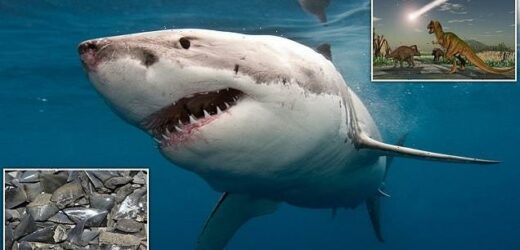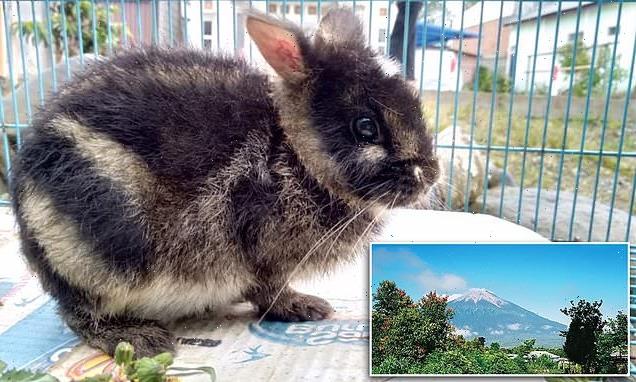Nature’s ultimate survivors! Asteroid that wiped out the dinosaurs 66 million years ago left sharks unscathed, analysis of teeth reveals
- Experts studied 1,239 shark teeth from nine species spanning 27 million years
- This covered a period from 83.6 million years ago to 56 million years ago
- This covered millions of years before and after the great extinction event
- They found sharks survived this event unscathed compared to other creatures
The asteroid that wiped out the dinosaurs and the majority of life on Earth 66 million years ago left sharks unscathed, according to a new analysis of ancient teeth.
Sharks are nature’s ultimate survivors, according to new research into the ancient fish species teeth by a team from Uppsala University in Sweden.
The city-sized asteroid that smashed into the Gulf of Mexico 66 million years ago wiped out almost all life on land and in the water, including the dinosaurs.
However, the new research, that involved analysing shark teeth to look for genetic diversity over time, revealed they were left unscathed by the catastrophic event.
They analysed 1,239 fossil shark teeth from nine different species, including eight currently alive and one extinct, spanning a 27 million year period.
Some shark species were in decline before the asteroid hit, but others began to thrive after the event and their ability to repair DNA damage may be why the apex predators were able to push through and go on to thrive to this day.
The asteroid that wiped out the dinosaurs and the majority of life on Earth 66 million years ago left sharks unscathed, according to a new analysis of ancient teeth
However, the new research, that involved analysing shark teeth to look for genetic diversity over time, revealed they were left unscathed by the catastrophic event
KEY FINDINGS: SHARK SPECIES CAME OUT OF GREAT EXTINCTION UNSCATHED
Researchers analysed 1,239 fossil shark teeth, including species in eight existing orders and one extinct order.
The teeth span a 27-million-year period from the late Cretaceous 83.6 million years ago to the early Paleogene 56 million years ago.
This covers the so-called K-Pg boundary that brought the age of the dinosaurs to an end.
The scientists found that shark dental diversity was already declining prior to the K-Pg boundary, but remained relatively constant during the mass-extinction event itself.
Some groups of apex predators, particularly those with triangular blade-like teeth, did suffer selective extinctions during the period studied, which may have been linked to the extinction of their prey species.
However, other shark lineages increased in dental diversity after the K-Pg boundary.
Lead author Mohamad Bazzi said the explosive event, that left a 93 mile diameter crater, was ‘not as dramatic for sharks as it was most other vertebrate lineages.’
The finding adds to evidence the iconic Great White and its cousins are the hardiest creatures on the planet, with an ability to repair its own DNA.
Great White sharks also have stronger immune systems than humans, enabling them to fight off a host of potentially deadly infections.
Sharks have been around for at least 450 million years – and have been dubbed ‘living fossils’ due to their extensive longevity.
‘Sharks are iconic marine predators that have survived multiple mass extinctions over geologic time,’ said Bazzi.
Few shark skeletons have been unearthed as they are made of cartilage, which is much softer than bone, and so rarely survives fossilisation.
Mr Bazzi said their prolific fossil record is represented mainly by isolated shed teeth, rather than bones as found in other ancient creatures.
The Swedish team scanned 1,239 teeth from nine species spanning 27 million-years, dating back to between the late Cretacious 83.6 million years ago and the early Paleogene 56 million years ago – after the asteroid hit the Earth.
Some groups of apex predators – particularly those with triangular blade-like teeth – suffered selective extinctions during the period.
It could have been due to the marine animals that they preyed upon dying out, but this was offset by other lineages increasing over time.
They included mackerel sharks in the Odontaspididae family – such as today’s Great White which evolved much later.
They are known for razor-sharp, fang-like teeth adapted for feeding on fish and their expansion coincided with the emergence of finned fish in the early Paleogene.
‘This pattern of selective extinctions may reflect an ecological shift from specialist tetrapod predators to more general bony fish diets,’ said Bazzi.
The study in PLOS Biology is the first global investigation of teeth shapes in multiple shark groups across the end Cretaceous mass extinction.
Mr Bazzi said: ‘Shark diversity was unaffected when the dinosaurs were wiped out.’
Some shark species were in decline before the asteroid hit, but others began to thrive after the event and their ability to repair DNA damage may be why the apex predators were able to push through and go on to thrive to this day
Mapping of the Great White’s genome has revealed mutations that protect it against cancer and other illnesses and scientists hope more research could one day allow these findings to be applied to treating illnesses in humans.
Unstable genes are what make us vulnerable to aged-related diseases, and sharks have been around for so long their DNA is more tolerant to damage over time.
Sharks could also help wound-healing and blood-clotting because of their ability to recover quickly from serious injuries.
Mr Bazzi added: ‘Ultimately, our study reveals a complicated morphological response to the end Cretaceous mass extinction.
‘It highlights an event that influenced the evolution of modern sharks.’
The findings have been published in the journal PLOS Biology.
KILLING OFF THE DINOSAURS: HOW A CITY-SIZED ASTEROID WIPED OUT 75 PER CENT OF ALL ANIMAL AND PLANT SPECIES
Around 65 million years ago non-avian dinosaurs were wiped out and more than half the world’s species were obliterated.
This mass extinction paved the way for the rise of mammals and the appearance of humans.
The Chicxulub asteroid is often cited as a potential cause of the Cretaceous-Paleogene extinction event.
The asteroid slammed into a shallow sea in what is now the Gulf of Mexico.
The collision released a huge dust and soot cloud that triggered global climate change, wiping out 75 per cent of all animal and plant species.
Researchers claim that the soot necessary for such a global catastrophe could only have come from a direct impact on rocks in shallow water around Mexico, which are especially rich in hydrocarbons.
Within 10 hours of the impact, a massive tsunami waved ripped through the Gulf coast, experts believe.
Around 65 million years ago non-avian dinosaurs were wiped out and more than half the world’s species were obliterated. The Chicxulub asteroid is often cited as a potential cause of the Cretaceous-Paleogene extinction event (stock image)
This caused earthquakes and landslides in areas as far as Argentina.
But while the waves and eruptions were The creatures living at the time were not just suffering from the waves – the heat was much worse.
While investigating the event researchers found small particles of rock and other debris that was shot into the air when the asteroid crashed.
Called spherules, these small particles covered the planet with a thick layer of soot.
Experts explain that losing the light from the sun caused a complete collapse in the aquatic system.
This is because the phytoplankton base of almost all aquatic food chains would have been eliminated.
It’s believed that the more than 180 million years of evolution that brought the world to the Cretaceous point was destroyed in less than the lifetime of a Tyrannosaurus rex, which is about 20 to 30 years.
Source: Read Full Article






